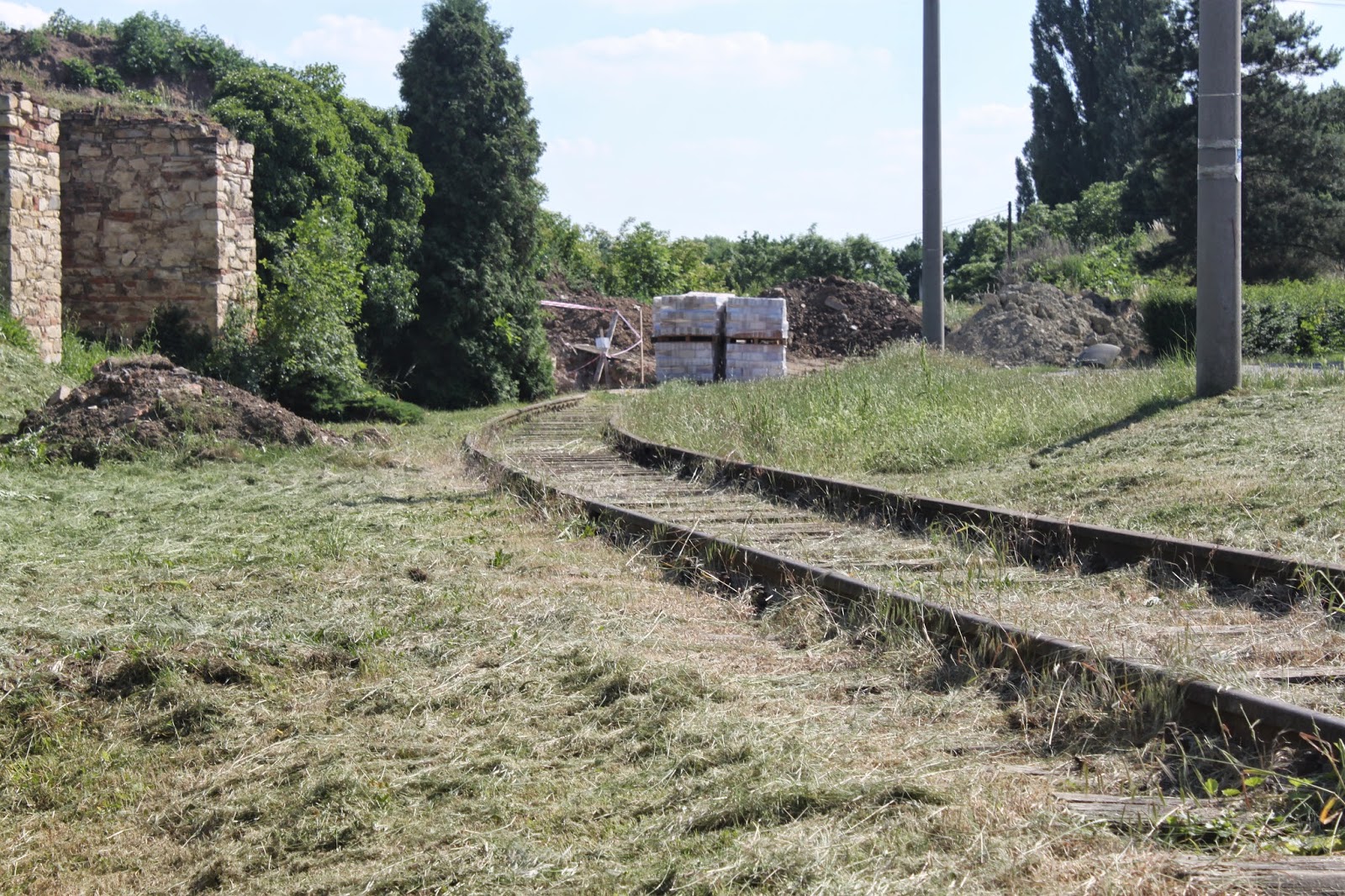Summer 2014 Blog Pt. 3 - Visiting Terezín
Ok, trying to catch up on the blog. Had some technical difficulties while in Prague, plus was spending a lot of time out of the flat.
Last week Hannah and I took the opportunity to visit the town of Terezín, located about an hour's train ride outside of Prague. The history of the town is long and complex, spanning centuries. Originally built as a military fortress in the late 1700s by the Habsburg Monarchy and named Theresienstadt after Empress Maria Theresa. The fortress survived the Austro-Prussian War in the mid 19th century and during WWI was used as a political prison. After WWI and the collapse of the Austro-Hungarian Empire it came under the jurisdiction of the newly formed Czechoslovakia.
Despite this long military history the town is probably best known today as one of Hitler's many concentration camps during WWII, though it is still less famous than other camps like Auschwitz, Dachau, or Sachsenhausen. I can only speak for the American education system but it certainly didn't feature any in depth history of WWII in general, let alone what the Jewish population in Europe suffered. Most of my knowledge of this period has come from a couple courses I've taken during my coursework for both my MA and now my PhD, particularly a course last semester specifically on memory and testimony of survivors of the Shoah--a term I had never heard before but one which more accurately describes what the Jewish communities suffered (in the old greek "holocaust" means something like "ritual sacrifice by fire," whereas "shoah" is Hebrew for "great calamity/catastrophe").
Despite a general lack of knowledge of European history during the mid-20th century, I had a little knowledge of Terezín prior to my visit due to periodic references to it during my years of studying/working in theatre. In high school I had the chance to perform in a production of "I Never Saw Another Butterfly", a one act play written by Celeste Raspanti, about a character named Raja, a child who survived in Terezín as well as the story of all the friends and family she lost. The play had an impact on me even then (I was 17 or 18). Many years later when I started teaching college theatre history and survey courses I included references and short YouTube videos about Terezín and the plays, poems, and artwork that were created there.
Terezín has an interesting history of being used as a "model" camp. Decoy camp was more like it. When word started to trickle out of Europe that Hitler and the Nazis were committing horrific acts, Terezín was opened up as a model camp for the Red Cross to come and tour. It was made to look like a lovely "retirement" community of sorts for Jewish people to come and live in. Of course many of them were transported to other camps to minimize the overcrowding. Though not an extermination camp, more than 30,000 people died in the ghetto, many of them children. Nearly 90,000 were transferred to extermination camps like Auschwitz.
This is just a very glossed overview of the history of Terezín, I highly recommend that people do more research. Two books I would strongly recommend are the two that I purchased at the Ghetto Museum, The Terezín Ghetto by Ludmilla Chladkova and I have not seen a butterfly around here, with an introduction by Jiri Weil. Chladkova's book is short but gives a good overview of the history of Terezín. I have not seen a butterfly around here, is an inspiring but heart wrenching collection of poems and artwork by the children of Terezín. It's a testament to the power of language and art to help transcend (even if only for a moment) pain and suffering.
What follows are a collection of my pictures from my visit to Terezín. Like the bit of history above, these pictures are not meant to be a comprehensive presentation of what it is to visit this town. I'll include captions where needed, but most will speak for themselves.
 |
| The day got off to an interesting start, we kept having minor difficulties getting transportation worked out. We ended up missing our stop and waited at the next train station to get a ride back to Buhosovice. We then took the bus to Terezin. |
 |
| The main town square. |
 |
| I have no photos to share of the inside of the Ghetto Museum as I didn't pay for the photo permission, but the museum is very well done and worth the visit. |
 |
| After the museum we walked around the town and explored the various sites. In the middle, by the museum, you'll find a fair amount of tourists, as you walk towards the outskirts a bit it starts to get quieter. |
 |
| One of the old barracks, dating back well before the Nazi occupation of the time. |
 |
| Another former military building. Most, if not all, of the buildings in Terezin have served multiple functions over their history from being part of a strategic military defense and fortress for the Habsburgs to the time of the Nazi occupation through its use by the Soviets after the war. |
 |
| Remnants of old transport train tracks. Not completely sure of the history. We read that when the Jewish citizens began to arrive they came by train to Bohusovice and then walked to Terezin (Hannah and I took the bus, but did end up walking about half of that route as we walked out of town to the memorial and then back in). But these tracks could have been part of the transport link to other camps when prisoners left Terezin. |
 |
| According to the Chladkova book this relief is by Bretislav Benda and commemorates "taking leave from home and departing by transport." |
 |
| According to Google Translate I think this translates (my best guess) to: "In these places (this place?) thousands of prisoners of the Terezin Ghetto took their last journey." |
 |
| Part of the original fortress defenses. |
 |
| There was no information about the etchings on these stones, so we don't know if they are original to the years etched or if people have added them afterwards in memory of family members. |
 |
| Looking back across the bridge that goes into Terezin. Incoming prisoners would have walked across the bridge and then headed to the right into town. |
 |
| Turning down onto the road leading to the crematorium and the memorial. |
 |
| The crematorium. It was badly damaged in a flood several years ago, the waters reached 13 ft high. In has since been restored and reopened, though it sounded like they were still doing some work. I can't quite describe what it felt like inside. |
 |
| Memorial to Soviet Soldiers who died during the liberation of Czechoslovakia in 1945. |
 |
| Part of the town cemetery, |
 |
| Markers for each country, as well as some mass graves. |
 |
| Looking back, we were now at the far end opposite where we had entered. It was a very quiet day, for most of our time wandering around the memorial and cemetery Hannah and I were the only ones there. It was both peaceful and a bit sad. |
 |
| Walking back out of the memorial area. |
 |
| Walking back into town we saw two cute little critters, it's hard to see in this shot, there's one on the grass in the middle of the shot and the other is at the edge of the water. Thanks to Google, we think they're European Otters. |
 |
| Walking back into the center of town. |
 |
| Here are the two books I mentioned as well as the map (in blue) that we used. It's worth getting as both a map and guide to all the historical sites, as well as to have as a souvenir.
So, that was our day. I would strongly urge you to visit Terezín should you ever visit Prague. There are tours that will take you directly there but since Hannah already knew her way around a bit and could navigate the train system we did our own thing. Had I been by myself I probably would have paid extra to do the full tour with a guide.
My lasting memory of Terezín is how quiet it was. I had not realized that it was an inhabited town once more, all the non-Jews had been evacuated so that it could be a complete ghetto/camp. At some point after the war residents returned and there is a community there once more, living side by side with this immense history. While some restoration has been done since the fall of communism the town of Terezín still has not yet been completely refurbished. Where much of Prague feels like it has been (or is currently in the process of being) restored back to it's glory days before the war and communism, Terezín (to me) had a bit of a feeling of "the town the world forgot". Hit hard through the centuries leading up to the 20th and then dealt a double blow with both Nazi occupation and then communism. When walking out to the memorial area the town was very quiet, almost isolated. I did notice though that as we took the bus back to Prague and went out a different direction there seemed to be more people and more activity. I will definitely be going back the next time I visit the Czech Republic and explore the area further.
Should you ever find yourself in Prague, please visit Terezín and learn more about its history and take a moment to remember the people, particularly the children, who lived there.
|

























































Comments
Post a Comment